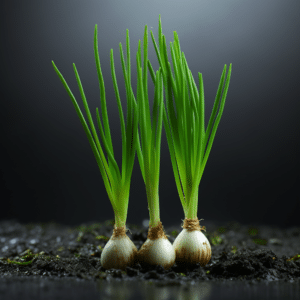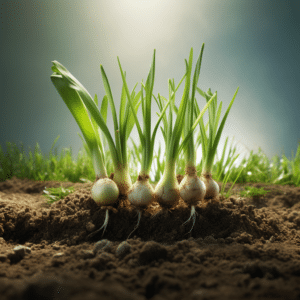Green onions, also known as scallions or spring onions, are a versatile and easy-to-grow vegetable that can add a fresh and flavorful kick to various dishes. Whether you’re a seasoned gardener or a novice with a green thumb, this comprehensive guide will walk you through the process of growing your own green onions and provide valuable tips to ensure a successful harvest.
Understanding Green Onions

Green onions, also known as scallions or spring onions, are a type of onion that are harvested before they fully mature. They have a long, slender green stem and a small white bulb at the bottom. The entire plant, from the bulb to the green leaves, is edible and imparts a mild onion flavor to your meals.
Green onions are widely used in various cuisines around the world. They add a fresh and vibrant touch to dishes, both as a garnish and as a main ingredient. Their versatility makes them a favorite among chefs and home cooks alike.
Health Benefits of Green Onions
Aside from their delicious taste, green onions also offer a range of health benefits. They are packed with essential vitamins and minerals such as vitamin K, vitamin C, and folate. These nutrients play a crucial role in maintaining a healthy body.
Vitamin K, for example, is important for blood clotting and bone health. It helps in the formation of proteins that are necessary for proper blood coagulation and contributes to the maintenance of strong and healthy bones.
Vitamin C, on the other hand, is a powerful antioxidant that helps protect cells from damage caused by harmful free radicals. It also plays a vital role in collagen synthesis, which is essential for maintaining healthy skin, blood vessels, and connective tissues.
Folate, also known as vitamin B9, is essential for cell growth and division. It is particularly important during pregnancy as it helps in the development of the baby’s neural tube, which eventually becomes the brain and spinal cord.
In addition to vitamins and minerals, green onions are also rich in antioxidants. Antioxidants help neutralize free radicals in the body, which can reduce the risk of chronic diseases such as heart disease and certain types of cancer.
Furthermore, green onions have been shown to have anti-inflammatory properties. Chronic inflammation is linked to various health problems, including heart disease, diabetes, and certain types of cancer. By incorporating green onions into your diet, you can potentially reduce inflammation and promote overall well-being.
It’s important to note that while green onions offer numerous health benefits, they should be consumed as part of a balanced diet. They can be enjoyed raw in salads, added to stir-fries, soups, and stews, or used as a flavorful topping for various dishes.
So next time you come across green onions at the grocery store or farmer’s market, don’t hesitate to grab a bunch. Not only will they add a burst of flavor to your meals, but they will also contribute to your overall health and well-being.
Preparing for Planting
When it comes to planting green onions, there are a few key factors to consider in order to ensure success. One of the most important aspects is choosing the right soil for your green onions to thrive in. Green onions prefer well-draining soil with a pH level between 6.0 and 7.5. This pH range provides the optimal conditions for the onions to absorb nutrients and grow healthy and strong.
To create the perfect soil environment for your green onions, it’s beneficial to improve the soil’s drainage. This can be achieved by incorporating organic matter into the soil, such as compost or well-rotted manure. These organic materials not only enhance drainage but also contribute to the overall fertility of the soil. By adding compost or well-rotted manure, you can create a loose and fertile soil structure that will support the growth of your green onions.
Selecting the Perfect Location
Aside from soil conditions, the location where you plant your green onions plays a crucial role in their overall development. Green onions thrive in sunny locations that receive at least six hours of direct sunlight per day. Sunlight is essential for the process of photosynthesis, which is responsible for the production of energy and the growth of the onion plants.
However, green onions are also quite adaptable and can tolerate partial shade. This makes them a versatile option for various garden setups. If you have areas in your garden that receive partial shade, you can still successfully grow green onions in those spots. Just make sure that the location you choose provides adequate sunlight for the majority of the day and offers some protection from strong winds.
When selecting the perfect location for your green onions, it’s also important to consider the proximity to other plants. Green onions can benefit from being planted near certain companion plants, such as carrots or lettuce. These companion plants can help deter pests and provide shade to the green onions, creating a mutually beneficial environment.
Furthermore, it’s worth noting that green onions can be grown in containers as well. If you have limited space or prefer container gardening, you can plant green onions in pots or raised beds. Just ensure that the containers have proper drainage holes and are placed in a location that receives adequate sunlight.
By carefully considering the soil conditions and selecting the perfect location, you can set your green onions up for success. Providing them with the optimal environment will encourage healthy growth and ensure a bountiful harvest of delicious and flavorful green onions.
Planting Process for Green Onions

When to Plant Green Onions
The ideal time to plant green onions is in early spring or fall, when the soil temperature is between 45°F and 75°F (7°C and 24°C). Avoid planting them during the hot summer months, as they can struggle to establish in extreme heat.
How to Plant Green Onions
To plant green onions, start by preparing the soil by removing any weeds and loosening it with a garden fork or tiller. Next, create furrows in the soil that are about half an inch (1.2 cm) deep and 4-6 inches (10-15 cm) apart. Place the green onion sets or seedlings into the furrows, spacing them about 2 inches (5 cm) apart. Gently cover the sets with soil and water thoroughly.
Caring for Your Green Onion Plants
Watering Your Green Onions
Green onions require consistent moisture to thrive, so it’s important to water them regularly. Aim to provide about 1 inch (2.5 cm) of water per week, either through rainfall or irrigation. Be careful not to overwater, as this can lead to rotting. Monitor the soil moisture and adjust your watering schedule accordingly.
Dealing with Pests and Diseases
Like any garden plant, green onions are susceptible to pests and diseases. Keep an eye out for common pests such as onion maggots and thrips. Regularly inspect your plants for any signs of damage or infestation, and take appropriate action by implementing organic pest control methods, such as introducing beneficial insects or using natural repellents.
Harvesting Your Green Onions

When to Harvest Green Onions
Green onions can be harvested at any stage of growth, depending on your preference. If you prefer a milder flavor, you can start harvesting them when the green leaves reach about 6-8 inches (15-20 cm) in height. For a stronger onion flavor, allow them to grow a bit longer until the leaves reach around 12 inches (30 cm) tall. Remember to harvest them before they bolt and produce flowers.
How to Harvest Green Onions
To harvest green onions, simply grip the base of the plant near the soil line and pull it gently. If the soil is dry, you may need to dig around the bulb slightly to loosen it. Trim the roots and any wilted or damaged leaves, and your green onions are ready to be used in your favorite recipes.
By following this comprehensive guide, you can confidently grow your own green onions and enjoy their fresh, flavorful taste in your culinary creations. Whether you’re adding them to salads, stir-fries, or salsas, homegrown green onions will elevate the flavors of your meals and provide you with a sense of pride in your gardening accomplishments. Happy growing!